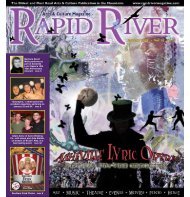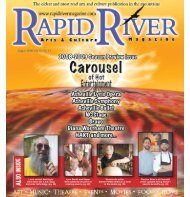winners of our annual poetry contest - Rapid River Magazine
winners of our annual poetry contest - Rapid River Magazine
winners of our annual poetry contest - Rapid River Magazine
You also want an ePaper? Increase the reach of your titles
YUMPU automatically turns print PDFs into web optimized ePapers that Google loves.
R A P I D R I V E R A R T S<br />
be mine valentine<br />
Why Do We Celebrate<br />
Valentine’s Day?<br />
to love or not<br />
to love that is<br />
the question…<br />
The history <strong>of</strong> Valentine’s Day is<br />
a combination <strong>of</strong> both Christian<br />
and ancient Roman legends and<br />
traditions. One prevalent version<br />
<strong>of</strong> the story involves a priest named<br />
Valentine in Rome during the<br />
third century.<br />
At that time Emperor<br />
Claudius decided that single men<br />
made much better soldiers than<br />
married men and so he made it<br />
illegal for young men to marry<br />
at all in case he needed them for<br />
battle. Valentine defied the decree<br />
and performed many secret<br />
marriage ceremonies. Claudius<br />
discovered this rebellious act and<br />
put him in the Tower <strong>of</strong> London<br />
awaiting his death sentence.<br />
While imprisoned he fell in love<br />
with the jailer’s daughter and<br />
wrote her a love poem signing<br />
it “from y<strong>our</strong> Valentine,” thus<br />
starting the tradition <strong>of</strong> the now<br />
famous valentine card.<br />
By the Middle Ages Saint<br />
Valentine was one <strong>of</strong> the most<br />
popular saints in England and in<br />
France. At that time in ancient<br />
Rome, February was the <strong>of</strong>ficial<br />
start <strong>of</strong> spring. During this time<br />
there was much being done to<br />
Christianize the pagan rituals and<br />
festivals. Prior to this, Valentine’s<br />
Day had been associated with the<br />
pagan Lupercalia festival at the<br />
Ides <strong>of</strong> February. It was a fertility<br />
festival dedicated to the god <strong>of</strong><br />
agriculture, Faunus, and to the<br />
founders <strong>of</strong> Rome itself, Romulus<br />
and Remus.<br />
On this day the members <strong>of</strong> Lupercalia,<br />
an order <strong>of</strong> Roman priests, would meet<br />
together at a scared cave where they would<br />
sacrifice a goat for fertility and a dog for<br />
purification. Young women put their names<br />
in an urn and all the available bachelors in<br />
the city would select a name. These two<br />
young people would be paired together for a<br />
full year. Sometimes this pairing would lead<br />
to marriage.<br />
Pope Gelasius, who was very instrumental<br />
in making these rituals and festivals<br />
appear more Christian, declared that this<br />
lottery was barbaric and definitely unchristian<br />
and had it outlawed. February 14th<br />
then became known as the Mating Day in<br />
France and England as it was widely known<br />
to be the beginning <strong>of</strong> mating season for<br />
birds. Mating Day was replaced fairly<br />
quickly by the much more romantic name<br />
<strong>of</strong> Valentine’s Day.<br />
The oldest known and actual valentine<br />
was a poem written by Charles, the<br />
Duke <strong>of</strong> Orleans, who was captured during<br />
the Battle <strong>of</strong> Agin C<strong>our</strong>t. He was imprisoned<br />
in the Tower <strong>of</strong> London and the<br />
poem was to his wife. Today this valentine<br />
is viewed by many at The British Library<br />
in London, England.<br />
Valentine's Day became<br />
associated with romantic love<br />
and was very popular in the<br />
High Middle Ages as people<br />
mutually exchanged love notes,<br />
or valentines as they became<br />
known. The notes were typi-<br />
cally heart shaped and depicted<br />
cupids and doves. By the 19th<br />
century this occasion was immersed<br />
in the fabric <strong>of</strong> English<br />
and French culture.<br />
In 1847, Esther Howland<br />
started a business in Worchester,<br />
Massachusetts, hand<br />
making valentines cards. These<br />
cards were based on the old<br />
British embossed paper lace<br />
valentines and she sold them at<br />
first through her father’s large<br />
book and stationery store. Today<br />
more than one billion cards<br />
are sold worldwide. An interesting<br />
fact is that women purchase<br />
more than 85% <strong>of</strong> those cards.<br />
After 1950 this custom<br />
extended to gift giving. These<br />
gifts included flowers (red<br />
roses became the favorite), and<br />
small chocolates packed in heart<br />
shaped boxes. It wasn’t until<br />
the 1980s that the diamond<br />
industry became involved and<br />
promoted Valentine’s Day as an<br />
occasion for giving jewelry.<br />
Over the past twenty years we at blue<br />
in Biltmore Village have noticed a great<br />
increase <strong>of</strong> jewelry gift giving for this time<br />
honored day for lovers. Our gallery is<br />
filled with all kinds <strong>of</strong> special gifts made<br />
by local artists, but jewelery is by far the<br />
most popular gift chosen. We make a great<br />
variety <strong>of</strong> rings, bracelets, necklaces, and<br />
earrings from 14k gold and featuring <strong>our</strong><br />
very special handcut natural stones and<br />
“safe and happy” diamonds from Australia.<br />
We hope you will truly love being a part <strong>of</strong><br />
this heartfelt holiday.<br />
Happy Valentine’s Day<br />
to Everyone!<br />
blue is open Tuesday through Saturday<br />
10:30 to 6 p.m. at 1 Swan Street in<br />
Historic Biltmore Village. Our website is<br />
also helpful – bluegoldsmiths.com.<br />
Vol. 13, No. 6 — RAPID RIVER ARTS & CULTURE MAGAZINE — February 2010 9
















